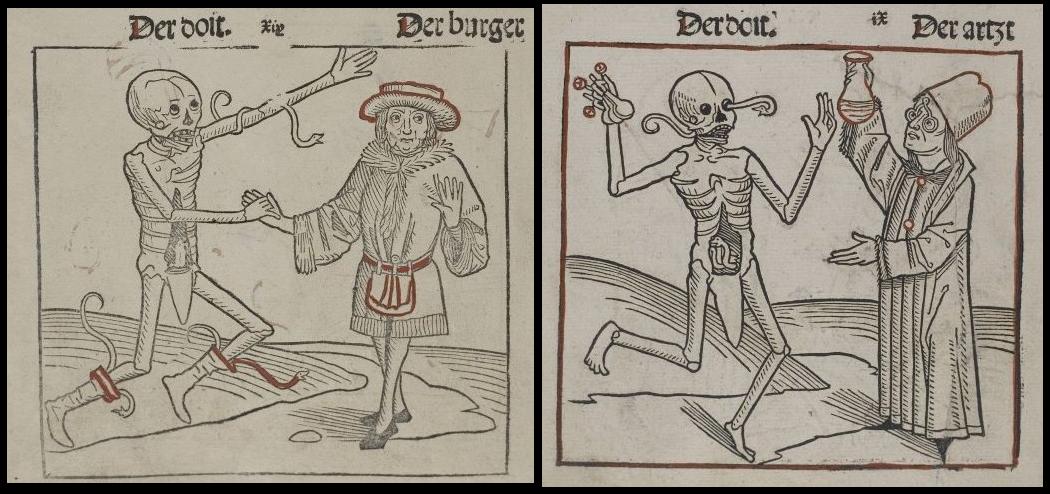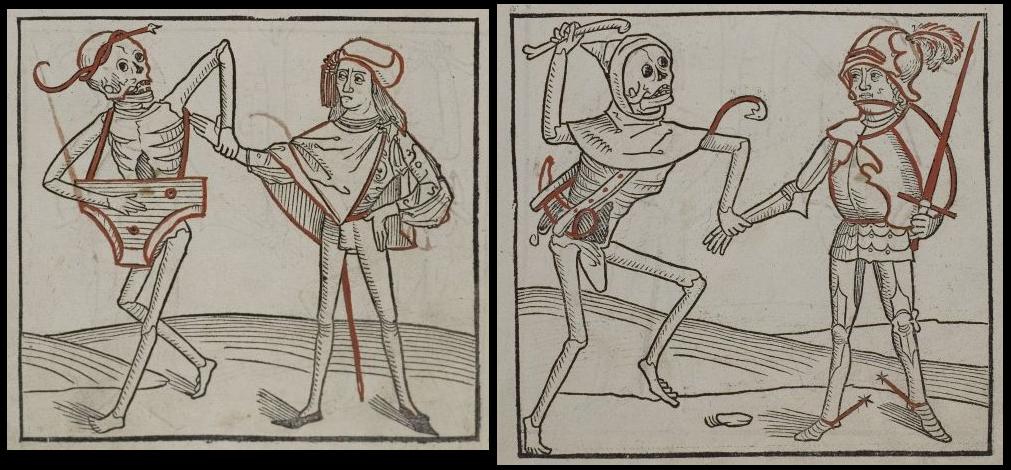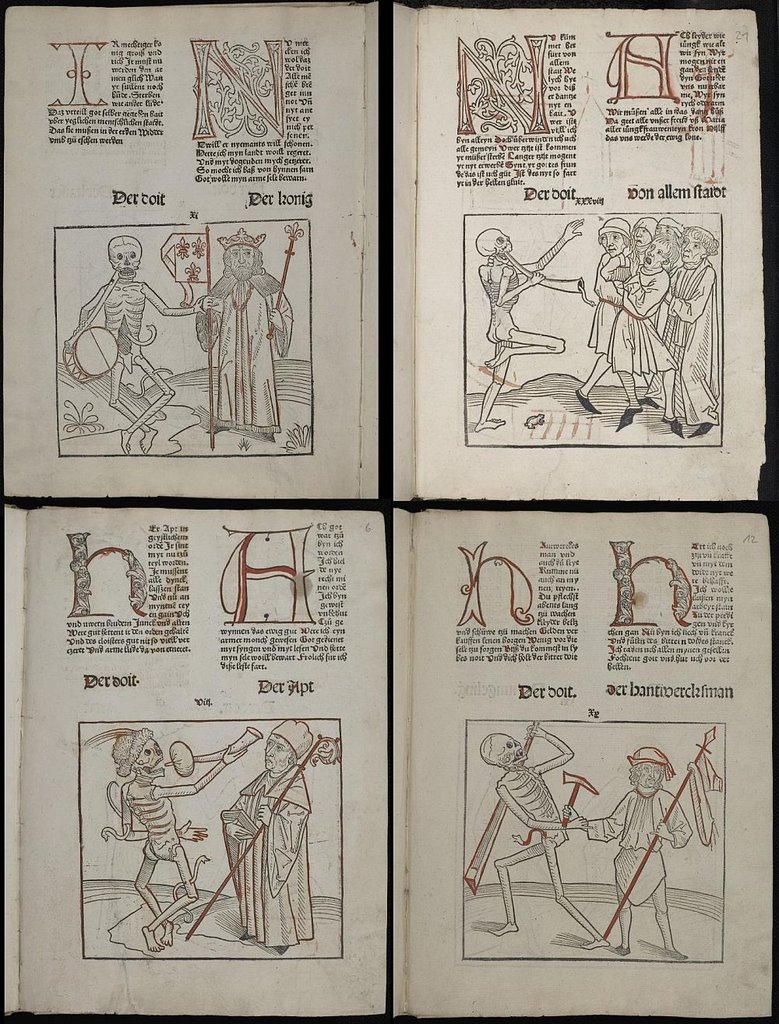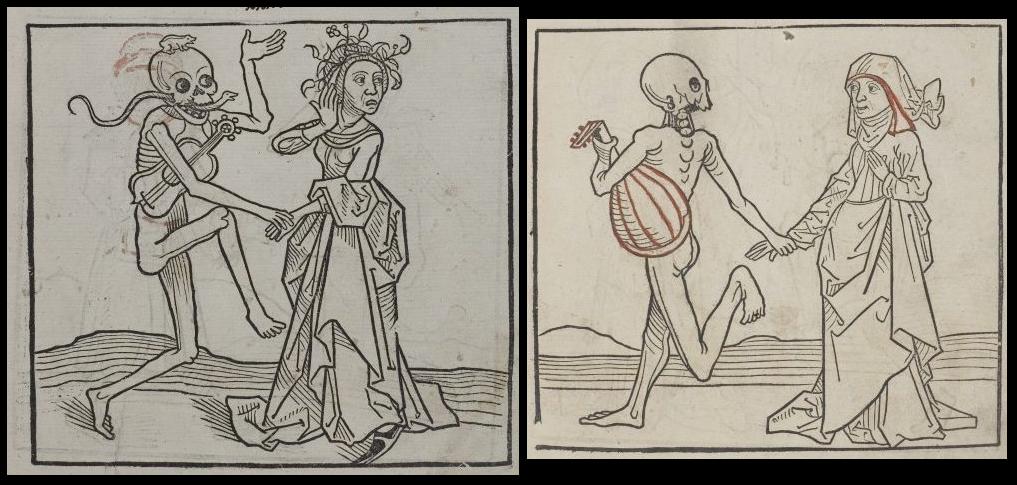









The Dance of Death or 'Le Danse Macabre' or 'Totentanz' or 'la Danza de la Muerte' was an artistic response across Europe to the devastation brought about by the plague or black death.
Although the origins are obscure, the idea of death visiting households without regard for social or economic status arose as a cultural phenomenon by way of dramatic plays. {Dante and Petrarch are mentioned as possible examples} The inevitablity of death was a reminder to be prepared by living a pious life: 'Memento Mori' -- 'Remember You Will Die'.
The earliest recorded artistic examples were frescoes in the Church of the Holy Innocents in Paris in 1424 (now gone). There are recordings of other church frescoes and paintings touching on the danse macabre theme in the the 15th century, most notably the paintings by Bernt Notke in St Mary's church in Lübeck, Germany in 1463. It is probably a little simplistic to think of the dance of death genre arising in isolation - pictures of death in cemeteries and churches had a long association with religious practises.
But it appears* that the incunabulum, 'Heidelberger Totentanz', was the first book in which the dance of death was portrayed. The author is unknown but it was printed by Heinrich Knoblochtzer in 1488 and contains a core series of 38 woodcuts in which the satricial emblem of death visits upon all manner of citizens. In most, the skeleton carries a musical instrument as a type of Pied Piper motif. The text, in a high German dialect, is addressed by death to its target.
[*There was an earlier work by Guyot Marchant in 1485 in which the paintings from the Church of the Holy Innocents were reproduced in 17 woodcuts (this is how we know about the original frescoes) and accompanied by text. So it's probably fairer to regard 'Heidelberger Totentanz' as containing the first dance of death illustrations produced solely for a book.
There is also some mention of 'Heidelberger Totentanz' having appeared in a different form in the 1460s but nothing I saw suggested I was reading an 'authority' - it's quite possible the woodblocks had been carved prior to 1488 however.]
{As a followup - which is to say, I'm still reading around after writing most of this - I have come across a couple of handwritten and hand-illustrated manuscripts from the 1460s which have depictions of totentanz - I'll probably check them out further for a future post. So maybe I'm being a little preemptive labelling 'Heidelberger Totentanz' as the first dance of death book; although that is how it's described everywhere.}
'Heidelberger Totentanz' is online in its entirety at the Universitätsbibliothek Heidelberg. Click the '+' button at the bottom of each page for very large pdf images.
- This site has some background analysis regarding the 'Heidelberger Totentanz' and has links to smaller copied versions of all the images at the bottom of the page - an easy way to see the rest of the illustrations beyond what I've posted above.
- Previous related posts (and associated links): i, ii, iii, iv.
- A wonderful series of Danse Macabre images at Cornell University's 'The Fantastic in Art and Fiction'.
- The Monumental Brass Society (with galleries).
- In french and semi-english, the Tapholov site has some unique images in its nooks.
- Did Notke paint the Dance of Death in Lübeck?
- This German site has quite a few small medieval images related to the plague.
- UPDATE: See: The Danse Macabre Collection.



















6 comments :
Fantastic entry and fantastic blog - you are an inspiration for anyone and everyone who wants to use the internet for the improvement of the species. Huzzahs around.
I wonder if there were any earlier ‘block-book’ dances-of-death. There were apparently block-books of the short version of the Ars Moriendi in circulation in the 1450s: I would imagine that the totentanz would likewise have lent itself to the format.
i love these! and thanks foer the pdf tip. do you know why the image of death seems to be drawn by a different artist about halfway through?
Funny thing that the first word that came to mind when I saw these dancing skeletons was "macabre"...and then my eyes came across your text and its source. :)
To misteraitch ... Yes, indeed there were block-books, as spookily enough one of them appears online at the same Heidelberg University site as part of Cod. Pal. germ. 438 Link : http://digi.ub.uni-heidelberg.de/diglit/cpg438/
And spookily enough denzen, I just posted about them a few days ago. Well timed. misteraitch is aware - we spoke among ourselves about that series some time ago.
Post a Comment
Comments are all moderated so don't waste your time spamming: they will never show up.
If you include ANY links that aren't pertinent to the blog post or discussion they will be deleted and a rash will break out in your underwear.
Also: please play the ball and not the person.
Note: only a member of this blog may post a comment.